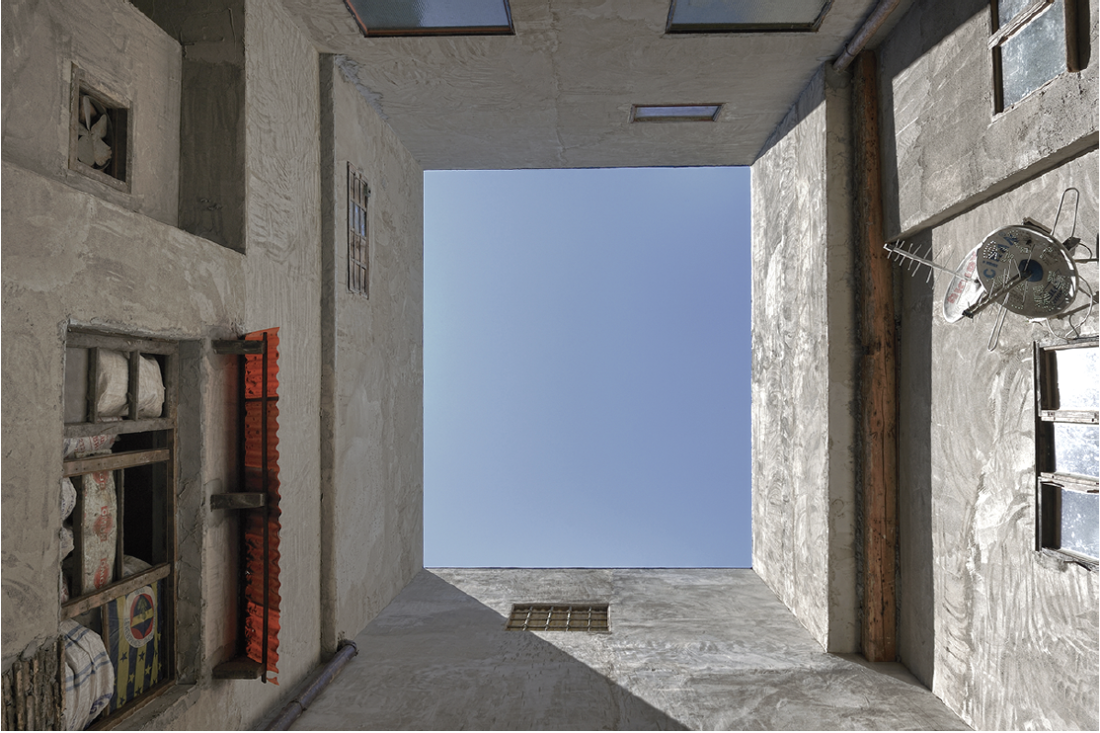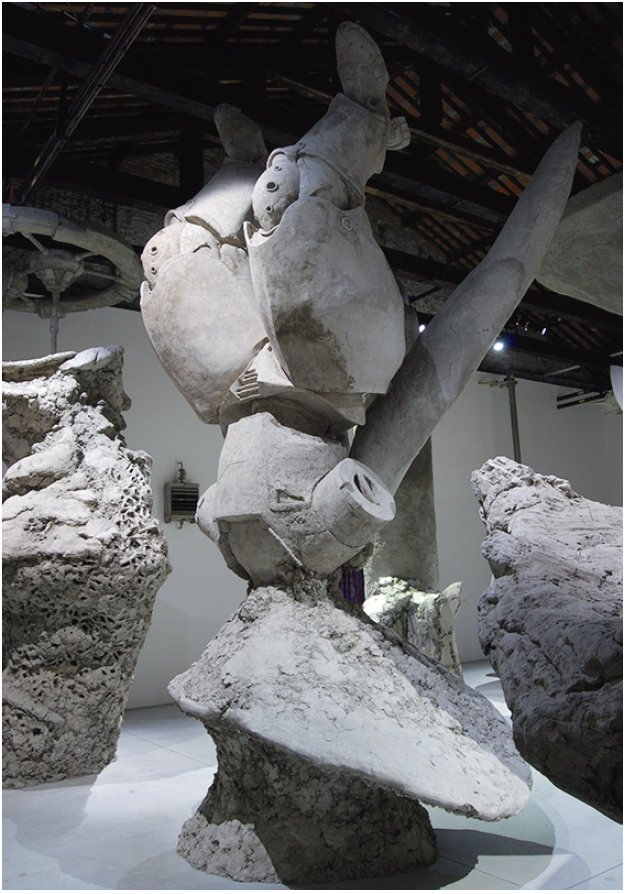Venice Biennale

Steven Shearer, façade view, Canada Pavilion at the Venice Biennale 2011. Photograph: Sebastiano Pellion di Persano.
The Venice Biennale’s 19th-century model, now perhaps considered conservative with its national pavilions, often initiates discussion surrounding the issues of national identity and representation. While it is not a new issue, this year established pavilions have taken different approaches and countries previously without permanent pavilions are now founding their own spaces. In tandem with the national pavilions, the International Exhibition (curated by Bice Curiger) is intended to represent a borderless approach to the Biennale. The title of the Biennale, “ILLUMInations,” suggests not only the aspect of light in art but also the act of shedding light on the institution itself and conventions that may require readdressing.
In the Giardini, Poland has for the first time selected a non-Polish national, Israeli artist Yael Bartana, as its representative. Poland’s history of anti-Semitism is addressed head-on in Bartana’s video trilogy …and Europe will be stunned. The works document a fictional political party, the Jewish Renaissance Movement in Poland, calling for the return of 3,300,000 Jews to Poland. Intended to function as a sort of collective psychotherapy for the two nations, the project also serves as an exploration of humanity’s readiness to accept the other and the intricacies of cultural integration.

Yael Bartana, Mur i Wieża (Wall and Tower), 2009, production photo. Photo: Magda Wunsche & Samsel. Courtesy Annet Gelink Gallery, Amsterdam and Sommer Contemporary Art, Tel Aviv.
Stephen Shearer’s installation in the Canadian pavilion includes drawing, painting, sculpture and a nine-metre façade featuring one of his poems: a visceral slew of words referencing black and death-metal vernacular. The towering façade situates the inconspicuous building between the superpower neighbouring pavilions of Germany and Great Britain. The British pavilion houses an ambitious installation by Mike Nelson: “I, Impostor.” The spacious building is transformed into a warren of disorienting, claustrophobic rooms with harsh lighting, low ceilings and detritus scattered on the dirty floors. The work is a continuation of a project first realized by the artist at the 2003 Istanbul Biennial: an intriguing reference to the historical relationship of Venice and Istanbul. The installation is perhaps misleadingly simple; Nelson, known for his clever transformations of spaces, has created an obviously constructed fictional world that is also very real.
In the Arsenale, new proposals for national pavilions are being explored in the hopes of providing permanent exhibition space to countries not represented in the Giardini. Also new is a series of “para-pavilions” created by four international artists for the purpose of exhibiting art by other artists (Chinese artist Song Dong’s para-pavilion for British artist Ryan Gander is a notable example.) Argentina’s modest space houses “The Murderer of Your Heritage,” a grouping of monumental concrete sculptures by emerging artist Adrián Villar Rojas. The exhibition is based on theories of multiverses in which the existence of multiple universes is possible, with the organic columnar sculptures meant to suggest how the course of humanity may have progressed differently in a parallel sphere.

Mike Nelson, I, IMPOSTOR, 2011, Installation view, British Pavilion; Venice Biennale 2011. Photograph: Cristiano Corte. Courtesy the British Council.
In India’s debut pavilion, Mumbai-based curator Ranjit Hoskote has attempted to animate the relationship between cultural citizenship and national identity, in turn portraying India as an entity that transcends borders. Three artists and one collective, each working in different media, have packed the exhibition (perhaps appropriately titled “Everybody Agrees: It’s About to Explode”), but it is New York-based Zarina Hashmi’s intricate works on paper and delicately gilded wooden forms that really shine. The Chilean pavilion (now in its second year) features Fernando Prats’s “Gran Sur,” a reference to the disastrous volcanic eruption in Chaitén in 2008 and the 2010 earthquake in south-central Chile. Prats’s quiet responses to these events take the form of painterly works created by dragging blank paper through the muck and debris at the sites of destruction. After Vittorio Sgarbi’s bombastic Italian pavilion, China’s inaugural space is a quiet refuge. The exhibition, entitled “Pervasion,” is evidently conservative, with numerous references to historical Chinese art. While not overtly challenging, the works remain successful in their quiet interpretations of natural themes.
Offsite, Mexico’s contribution is a video/installation project by British-born Melanie Smith, who has lived and worked in Mexico City since 1989. The work, entitled “Red Square, Impossible Pink,” questions the Eurocentric, colonialist conception of modernity and investigates the implications of these utopic projections for socio-political experience in Latin America. Comprising two video works and a series of baroque rooms converted to cabinets of curiosities, the strongest work conceptually is an intimate 35mm film of the garden Las Pozas in Xilitla, created by British Surrealist Edward James. The film documents the disassembly of several of the construction mechanisms James used; in this way Smith attempts to disassemble the modern European gaze and examine the relationship between modern and contemporary art practices.

Installation view of Adrián Villar Rojas’s exhibition at the Pavilion of Argentina, 2011. Photograph: Oliver Haas. Courtesy the 54th International Art Exhibition – la Biennale di Venezia.
Karla Black’s installation of “almost objects” at the Scottish pavilion is housed offsite in the 15th- century Palazzo Pisani Moretta with its noted Tiepolo ceilings. Her aesthetic is a satisfying combination of saccharine colour and coarse material—gilded cardboard and unidentifiable papier-mâché forms covered in glitter, mounds of topsoil sprinkled with crumbled pigment, smashed bath bombs alongside heaps of crumpled cellophane. The palazzo’s pastel walls and remnants of baroque embellishments are an ideal setting for the work. In three rooms connected by a corridor, a carefully swept allée leads the viewer between piles of dirt and bits of highly scented soap carved into faceted, jewel-like shapes: one of the more successful combinations of art and architecture in this Biennale.
Curiger’s ambitions to present new interpretations of the contemporary in the context of this Biennale are laudable. Three Tintorettos have been included in the international exhibition in an attempt to reconsider the implications of history in contemporary art; Curiger’s intent was not to form tenuous superficial analogies between the Tintorettos and the contemporary art surrounding them but to engage a kind of “anti-classical” energy. However, the works by the old master seem hopelessly incongruous, contextualized only by an installation of Maurizio Cattelan’s taxidermied pigeons in the rafters. More successful components include Jack Goldstein’s sparkling video The Jump and Pipilotti Rist’s video projections on paintings.
It will be interesting to see what direction the Biennale takes in the future and how global influences will shape its organization, and it is positive to see that new approaches to its current structure are taking place. Perhaps in the end, as an existing model, the Biennale serves well as a platform or reference point from which to address the relationship between art and nation, and how these two concepts continue to inform each other. ❚
The Venice Biennale runs from June 4 to November 27, 2011.
April Steele is an independent curator and writer based in Toronto.

